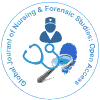Forensic Odontology: A Crucial Tool in the Legal and Medical Fields
Received: 02-Mar-2025 / Manuscript No. gnfs-25-163864 / Editor assigned: 05-Mar-2025 / PreQC No. 31-01-163864(PQ) / Reviewed: 19-Apr-2025 / QC No. gnfs-25-163864 / Revised: 23-Apr-2025 / Manuscript No. gnfs-25-163864 (R) / Published Date: 29-Apr-2025 DOI: 10.4172/2572-0899.1000329 QI No. / gnfs-25-163864
Abstract
Introduction
Forensic odontology, also known as forensic dentistry, is the branch of forensic science that deals with the examination and evaluation of dental evidence in criminal investigations and legal matters. It plays a pivotal role in identifying human remains, investigating bite mark injuries, and assisting in cases involving abuse or assault. Forensic odonatologists apply their expertise in identifying individuals through dental records, which is particularly valuable in mass disaster scenarios, missing person investigations, and the identification of victims of violence [1, 2].
Key Aspects of Forensic Odontology
- Identification of Human Remains One of the most significant roles of forensic odontology is the identification of human remains. Teeth are among the hardest and most durable structures in the human body, often surviving long after other tissues have decomposed. Dental records, such as X-rays, dental charts, and photographs, can be compared with the remains to confirm the identity of a deceased individual. This process is invaluable in cases where other means of identification, such as fingerprints or DNA, are unavailable.
- Bite Mark Analysis Bite mark evidence can be a critical factor in criminal investigations, particularly in cases of assault or sexual abuse. Forensic odonatologist’s can analyze the pattern, size, and shape of bite marks left on victims' bodies or objects to identify the perpetrator. By comparing the bite marks with dental impressions, they can sometimes match the bite to a specific individual, providing crucial evidence in legal proceedings.
- Age Estimation Forensic odonatologist’s can estimate the age of an individual based on the examination of their dental development. This is especially useful in cases where the victim’s identity is unknown, such as in the case of an unidentifiable body or a missing person. By analyzing the eruption of teeth in children or the wear and tear of teeth in adults, forensic odonatologist’s can provide an estimated age range, assisting law enforcement in narrowing down potential identities.
- Analysis of Dental Trauma and Abuse Forensic odonatologists are frequently called upon to assess cases of child abuse or domestic violence. The presence of trauma to the teeth or mouth can indicate physical assault or neglect. By analyzing patterns of injury, forensic odonatologist’s can determine the nature of the trauma and its potential cause, whether it’s from physical force, impact with objects, or bite wounds.
- Mass Disaster Victim Identification In the aftermath of natural disasters, accidents, or terrorist attacks, forensic odonatologist’s often assist in the identification of victims. Dental records are essential in such cases because they provide a reliable and identifiable set of data. The examination of dental remains can expedite the identification process, helping families to claim their loved ones and allowing authorities to determine the full scope of the tragedy.
Training and Skills Required
Forensic odonatologists are highly trained professionals, typically holding a dental degree (DDS or DMD) and having specialized training in forensic science. They must be proficient in dental anatomy, pathology, radiology, and the methods used in identifying bite marks and trauma. A key component of their work is maintaining an extensive knowledge of dental records and ensuring proper documentation of evidence to be used in court.
In addition to their scientific expertise, forensic odonatologist’s must possess strong communication skills. They are often called to testify in court, presenting their findings in a clear and concise manner. Their testimony can play a pivotal role in the outcome of criminal cases, making it essential for them to be able to explain complex dental findings to a lay audience, including judges and jurors [3-6].
Challenges in Forensic Odontology
Despite its significant contributions to the field of forensic science, forensic odontology is not without its challenges. One of the primary challenges is the variability in bite mark analysis. Critics argue that bite mark identification can sometimes be unreliable due to the subjective nature of comparing bite patterns. Differences in skin elasticity, the angle of the bite, and the level of force applied can all impact the mark’s appearance, leading to potential inaccuracies.
Another challenge is the accessibility of dental records. In cases where individuals do not have a dental history or their records are incomplete, forensic odonatologists may struggle to establish a definitive identification. Privacy concerns also limit the accessibility of dental records in some jurisdictions, which can complicate investigations [7-10].
Conclusion
Forensic odontology is a crucial sub discipline within the broader field of forensic science. From identifying remains to investigating bite marks and abuse, forensic odonatologists provide essential services that aid in solving criminal cases, identifying victims, and ensuring justice. As technology continues to advance, the role of forensic odontology in criminal investigations is likely to grow, with new methods and tools enhancing its accuracy and effectiveness.
Citation: Citation: Louie P (2025) Forensic Odontology: A Crucial Tool in the Legal and Medical Fields. Glob J Nurs Forensic Stud, 9: 329. DOI: 10.4172/2572-0899.1000329
Copyright: Copyright: © 2025 Louie P. This is an open-access article distributed under the terms of the Creative Commons Attribution License, which permits unrestricted use, distribution, and reproduction in any medium, provided the original author and source are credited.
Select your language of interest to view the total content in your interested language
Share This Article
91勛圖 Journals
Article Tools
Article Usage
- Total views: 160
- [From(publication date): 0-0 - Aug 30, 2025]
- Breakdown by view type
- HTML page views: 127
- PDF downloads: 33
